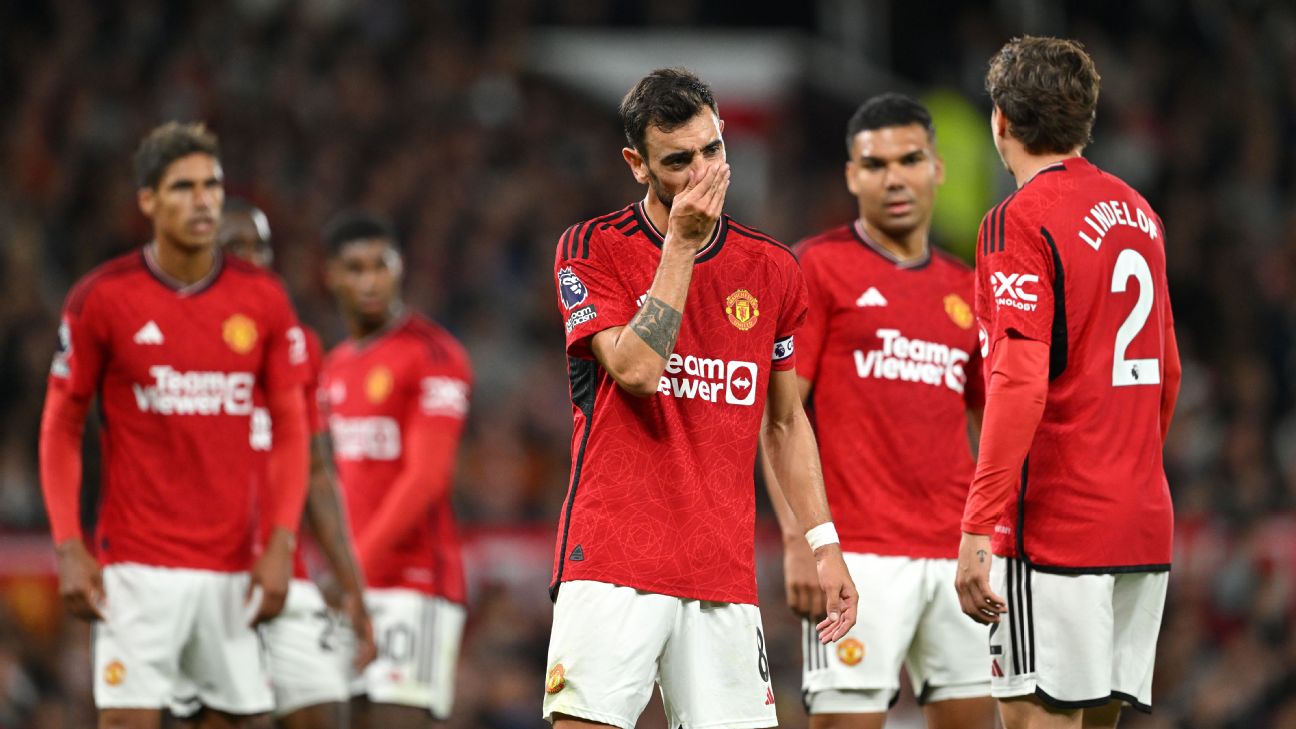You have our permission: You’re finally allowed to start telling everyone your opinions about the Premier League.
Who are we kidding? That hasn’t stopped you — and it hasn’t stopped us. However, the 10-game mark is right around here, and it’s traditionally when teams start to look like we might expect them to look for the rest of the season. Analytically, the data profiles of each club start to become a little more predictive of future performance after 10 games, too.
While things like penalties, red cards and schedules still haven’t totally evened out at this point — Liverpool already have four red cards, Arsenal already have been awarded six penalties, the rest of the league is averaging one of each — the distribution is much more equal than it was the last time we did this ranking. So, 10 games into the Premier League season, we’re doing it again.
Ryan O’Hanlon and Bill Connelly have each ranked all 20 sides, 1-20, and then combined their rankings to produce one master ranking. The criteria? Who we think would win a match if any of these teams played each other on a neutral field in the near future. The updated rankings are below, followed by some analysis of the most notable changes (or non-changes) from the previous edition of the rankings.
The updated rankings
September and October’s rankings — the combination of Bill and Ryan’s individual rankings — are listed along with the new adjustments, plus each team’s present points totals on the Premier League table and goal differential:
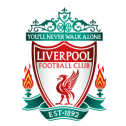
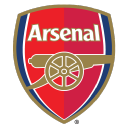 Liverpool and Arsenal: The battle for second continues
Liverpool and Arsenal: The battle for second continues
When we last ranked these teams four matches into the season, Liverpool crept ahead of Arsenal into second place. For now, the Reds stay there, but the margins are tiny.
In the weeks since our last ranking, Arsenal have pulled 14 points from six league matches, while Liverpool pulled 13. Arsenal drew with Spurs at home, while Liverpool lost 2-1 away (you probably remember this one). The Gunners defeated Manchester City but drew at Chelsea, and Liverpool drew at Brighton.
Against a slightly easier set of opponents, per Stats Perform, Arsenal has generated one more point overall, with a slightly better goal differential (+15 vs. +14) and slightly better xG, or expected goals, differential (+11.0 vs. +10.2). It’s almost dead even, though if we were to use European play as a further evaluation, Arsenal’s loss to Lens, currently 10th in Ligue 1, is certainly worth a demerit.
Regardless, despite Spurs’ bright start and Newcastle’s strong fundamentals, it still feels like Liverpool and Arsenal have the best combination of potential and known quality to challenge Manchester City over a 38-match season (if anyone can).
For Arsenal, new addition Declan Rice has settled in beautifully, fulfilling all the primary roles of a solid defensive midfielder, ranking second on the team in ball recoveries, progressive carries and pass attempts and contributing two goals and two assists from 10 chances created. Up front, not only has Bukayo Saka scored five goals (tied for first on the team) with six assists (first) from 33 chances created (first) in all comps, but the team has gotten a combined nine goals and two assists from Eddie Nketiah and Gabriel Jesus. Nketiah’s hat trick charged Arsenal’s 5-0 win over Sheffield United on Saturday — if he’s able to take a sustained step forward, manager Mikel Arteta can use Jesus in an increasingly flexible way.
Granted, two of Arsenal’s other big-money summer additions, Kai Havertz and Jurriën Timber, have not yet worked out — Timber because he tore his ACL, Havertz because no manager seems to know where he should play to get the most out of him. (As a backup in the Arsenal midfield, Havertz has one goal and one assist in 922 minutes in all competitions.) But Arsenal are still playing mostly well and hold a distinct advantage over Liverpool in terms of the volume of shots they aren’t allowing.
Liverpool, of course, holds the same advantage in attack. The Reds are second in the league in shots, first in unblocked shots and first in xG. Hot finishing from both Nketiah and Leandro Trossard has given Arsenal the same number of goals, but Liverpool’s fundamentals are stronger.
Newcomers have had a big part to play in that. Dominik Szoboszlai leads Liverpool in touches, ball recoveries and chances created (he’s fourth in the league in both chances and ball recoveries, too), and Alexis Mac Allister is both a sturdy defensive midfielder and a metronome in buildup play. He’s second on the team in touches and first in pass attempts (and he completes 88% of them). And while Ryan Gravenberch couldn’t make it work at Bayern Munich under either Julian Nagelsmann or Thomas Tuchel, he’s quickly begun to thrive under his new manager at Liverpool, Jurgen Klopp. In just 477 minutes in all competitions, the 21-year-old has already produced two goals and two assists from 13 chances created. He’s put nine of his 11 shot attempts on goal. He’s also already intercepted seven passes.
Throw in sturdy work from veteran Wataru Endo, and newcomers have completely transformed Liverpool’s midfield in exactly the way it needed to be transformed. The ball is still filtering constantly to Liverpool’s attackers and while opponents are attempting a decent quantity of shots, they aren’t creating nearly the quality of shots Liverpool allowed last season.
Liverpool and Arsenal are both really strong teams. Liverpool have lost only to Spurs, in controversial fashion, since April 1, and while Arsenal somehow slipped up to Lens, they also beat Manchester City for the first time in about 68 years. (Okay, it was only about eight.)
Take your pick as to which one represents City’s strongest challenger — the correct answer is probably “neither,” but let’s not think about that for now. —Connelly

 Newcastle and Tottenham: Performance or results?
Newcastle and Tottenham: Performance or results?
Here’s a question for you: Were you — yes, you — an anthropomorphized soccer club 10 games into your Premier League season, would you rather be one with a track record of legitimately elite underlying performance against a genuinely difficult schedule? Or one with decent performance — and nine more points than the other club I gave you the option of being?
In other words, would you rather be Newcastle or Tottenham?
Here’s the Premier League, sorted across two metrics: non-penalty expected-goal differential and strength of schedule:
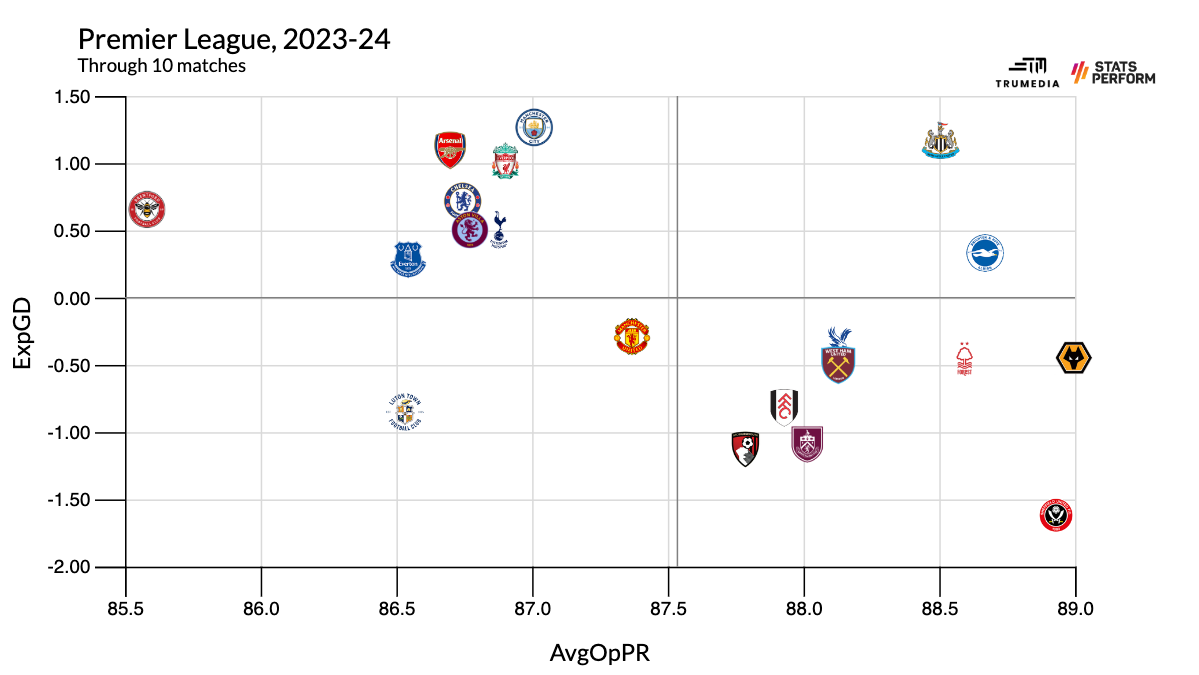
The strength of schedule rating comes simply from taking the average of the Stats Perform power rating of a team’s opponents. It doesn’t control for home and away matches, so it’s not perfect, but it’s still useful. Newcastle and Brighton are the only two clubs to play a harder than average schedule thus far and produce a better than average non-penalty xG differential.
It’s not that Newcastle have just been above average at out-creating their opponents. No: they’ve been better at doing it than everyone other than the best team in the world. Their performance level was fantastic last season, and coming into this campaign, I chalked some of that up to the weird World Cup interruption in 2022-23, no European soccer and a confluence of career years from a number of players that had never been this good in the past. Based on all that, I expected some regression. Instead, the only regression has come in the mostly random realm of shot conversion.
Although Newcastle are now backed by the richest owner of any team in all of global professional sports, this hasn’t been a talent explosion in the style of Manchester City or Paris Saint-Germain. The roster is different than it was two years ago, but not different enough to explain this. Newcastle’s 10 most used outfield players are defender Dan Burn, defender Fabian Schär, midfielder Bruno Guimarães, defender Kieran Trippier, attackers Anthony Gordon and Miguel Almirón, midfielder Sean Longstaff, forward Alexander Isak, midfielder Joelinton and defender Sven Botman. Somehow, that group of players is still performing at a level that easily puts them among the best teams in the word. A bunch of them are probably better than I gave them credit for, but their manager, Eddie Howe, is really just doing a fantastic job.
And so is everyone in North London’s favorite Aussie, Tottenham manager Ange Postecoglou.
Real quick: The idea that Tottenham are better without Harry Kane is absurd — let’s stop overcomplicating this sport, OK? Every team would be better with Harry Kane. That said, Tottenham are a lot better than last year. “Well, duh,” you might say, “they’re top of the table.” But I’m not talking only about points. They’re better in all the sustainable ways, too.
-
Non-penalty xG differential: 0.66 in 23-24, 0.15 (2022-23)
-
Final-third possession: 63.4% in 23-24, 42.9% (2022-23)
-
Penalty-area touches: 39.5 in 23-24, 23.45 (2022-23)
-
Opponent pass-completion percentage: 78.3% (2023-24), 83.3% (2022-23)
So, Spurs lost maybe the best player in club history and drastically improved while also implementing a much more possession-dominant, front-foot style. Hopefully Postecoglou’s success in Tottenham inspires clubs to hire coaches outside of the typical pool of retreads and former stars.
I said it at the time, but the fact that Postecoglou had to work his way up the ladder — proving himself through success in Australia, Japan and Scotland — meant that he was more likely to be a successful coach at a big club than some big-name player with no experience or a guy with just one or two jobs coaching teams with much more talent than their competitors.
That said, Spurs are not this good. No other team in the Premier League is beating its xG totals by even two full goals on both ends of the field. Spurs are 4.2 goals ahead of their xG on the attacking end and 3.7 ahead of it defensively. While I’ll concede that any team with an all-time great finisher in Son Heung-Min is likely to beat its xG offensively (though not at this rate), there’s just no world where Tottenham’s incredibly aggressive, live in the opposition box, press you to death style would create any kind of sustainable defensive over-performance. They haven’t allowed more than a goal in a game since Sept. 24. I doubt that’ll continue to hold.
While Newcastle have their own sustainability questions — mainly, how the heck are these players still producing something this good? — I think they’ll win more points than Tottenham over the final 29 matches. But will they win nine more? The gap between them isn’t that big. —O’Hanlon
 Aston Villa: Can they keep rising?
Aston Villa: Can they keep rising?
Over the last five Premier League seasons, the title-winning team has averaged 93.0 points, or 2.45 per game. The second-place team has averaged 2.25 per game, third place 1.87 and fourth place 1.82.
In this stratified start, five teams are currently averaging 2.2 points per game or better — in other words, five teams are playing at a top-two level. (Four teams are also playing at a bottom-two pace of 0.7 points per game or worse.) Among this top five are three complete and total non-surprises (Arsenal, Manchester City, Liverpool), a fourth familiar name (Spurs) … and Aston Villa, with 22 points in 10 matches.
Never mind a top-two pace: the last time Villa even finished in the top five was 1996-97. Dwight Yorke had not yet left for Manchester United. Hanson’s “MMMBop” had not yet reached No. 1 on the charts in England. Sheffield Wednesday was still in the Premier League (and finished seventh!). What we’re saying is it was a while ago. But here they are, and not only are they backing up last season’s pace — they’re exceeding it.
Villa averaged 1.96 points per game after hiring Unai Emery as manager on Nov. 1 last season, and it was enough to sneak them past Spurs and into seventh place. It earned them a spot in the Conference League, where they started with a dud (a loss at Legia Warsaw) but have since won two in a row. In league play, they endured early blowout losses to Newcastle and Liverpool (by a combined 8-1) and long-term injuries to Emiliano Buendía and Tyrone Mings to take 16 points from their last six matches and rise considerably in these rankings.
Villa have spent at a high level in recent years and have given Emery reinforcements at every level of the pitch, from attacking midfielder Moussa Diaby up front to center-back Pau Torres in the back, and he has pieced together one of the most possession-friendly units in the league. They’re fourth in average possession time, fourth in average possession length and fourth in progressive carry rate. They have a proper sweeper keeper in Emiliano Martínez, they can force the issue in tighter spaces (third in fouls suffered, third in penalties won), and they can press well enough — or at least pick their spots well enough — to have created the third-most goals from high turnovers.
Their overall defensive profile, however, is one of passivity. They give you almost as many long possessions as they take for themselves, and that will likely catch up to them. Plus, they haven’t really beaten anybody good — unless Chelsea counts, which is debatable — and they’ve played the sixth-easiest league schedule thus far, per Stats Perform.
Still, Villa have also dominated in their wins and they’re first in the league in goals and assists. Four different players have combined at least five goals and assists thus far, led by Ollie Watkins, who has five of each. His recent form was strong enough to earn him his first England national team call-up in 18 months.
Even with less sound defensive numbers, Villa have the fifth-best point total, the sixth-best goal differential and the eighth-best xG differential. If nothing else, this seems like a team ready to battle to play in Europe again next season. Even if it was against an easier slate, they’ve spotted themselves a five-point lead over Newcastle and Brighton, seven over Manchester United, eight over West Ham and 10 over Chelsea.
They have a chance to build even more of a cushion, too. Their next two league matches are against Nottingham Forest and Fulham, and after playing at Tottenham on Nov. 26, they get a tune-up against Bournemouth before the biggest week at Villa Park in decades: Manchester City visits Dec. 6, then Arsenal on Dec. 9.
Their dreams of Champions League play may be on life support after that, but this might not be the only season Villa play in one European competition or another. —Connelly
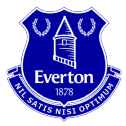
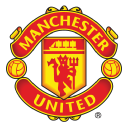 Everton and Manchester United: a tale of two underachievers
Everton and Manchester United: a tale of two underachievers
The worst-run clubs in the Premier League are, without much question, Everton and Manchester United.
The former were arguably the richest club outside of the Big Six, and they used those resources to create a team that … barely avoided relegation last season and are currently staring down a potential 12-point deduction for violating the Premier League’s financial regulations. With a savvier approach to team-building over the past 20 years, there was no reason why Everton couldn’t have become Tottenham, the team that joined the old top four (United, Chelsea, Liverpool and Arsenal) and Manchester City to form the Big Six. Instead, they became one of the clubs genuinely at risk of being relegated at the start of every season.
Man United are the Everton of the super-clubs, then. The Deloitte Money League rankings, which purport to calculate the revenues of the 30 richest clubs in the world each season, have never put United below fifth since they were first published in 1997. Only Real Madrid (2.04) have a higher average rank than United’s (2.31). Despite that, United haven’t won the Premier League in any of the previous 10 full seasons, and they never even genuinely challenged for the title in any of them either. They have only finished top four in half of those campaigns, and their average finishing position is higher (4.4) than fourth.
Outside of someone actively trying to make the team bad, it’s pretty much impossible to have Man United’s resources and be as bad as they’ve been.
Given the timelines of failure for both Everton and Man United, most of the blame belongs with ownership and the infrastructures they’re created — or failed to create. They’ve been the only constants or near-constants over these awful eras, and the long-term outlooks for both clubs probably won’t change until ownership changes. However, that doesn’t mean that either club is destined to only have disappointing seasons. Some coaches and players can still find success amid the toxic atmospheres at each club. And others can even underperform an already expected underperformance. Just take a look at both clubs this season.
Although Everton’s results haven’t quite matched their performances yet this year, they have simply been genuinely good so far. Through 10 matches, they have the eighth best non-penalty xG differential in the Premier League at +4. And they’re broadly what you’d expect from a Sean Dyche team: first in xG from set pieces, fourth in xG from counters, second in crosses per game and third in percentage of their passes that are played forward, per Soccerment.
Everton don’t only sit deep and defend, though. Instead, they’re middle of the table across Soccerment’s various pressing metrics: PPDA, build-up-disruption percentage and gegenpressing intensity. A more aggressive defense has, in turn, helped make the attack more productive. And although Everton currently sit in 16th place, their performances would normally put them in 10th place, per Soccerment’s expected-points calculations.
By that same metric, Man United should be one spot behind Everton, in 11th. The scary part about their current season, then, is that they’re currently in eighth — and that probably oversells how well they’ve been playing. It didn’t surprise anyone that they lost to Manchester City over the weekend, but don’t let the inevitability of the result distract you from how bad United really were.
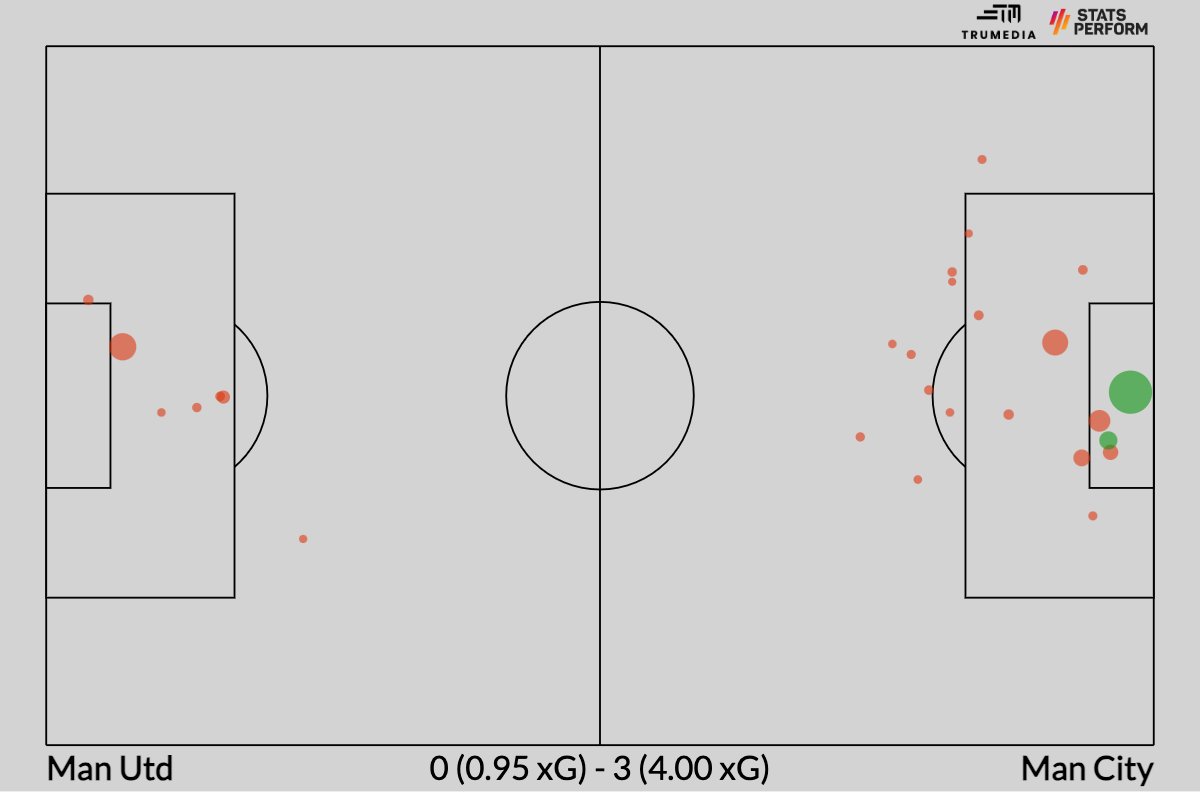 Non-penalty expected goals (xG) from Man City’s 3-0 win over Man United on Sunday. Green are goals. The larger the dot, the higher the xG.
Non-penalty expected goals (xG) from Man City’s 3-0 win over Man United on Sunday. Green are goals. The larger the dot, the higher the xG.
Strip out the penalties, and seven teams have been out-created by a two-xG-or-more margin in a match this season: Luton and Sheffield twice, then Burnley, West Ham, Nottingham Forest, Fulham and United on Sunday. (Luton, somehow, won one of their games, against Everton.) We should expect United to lose to Man City, but we shouldn’t expect them to get dominated like they’re a newly promoted club.
Now, United have suffered a bunch of injuries, and Sunday’s back seven was quite unimpressive: a back four of Diogo Dalot, Harry Maguire, Jonny Evans and Victor Lindelöf, behind a midfield of Sofyan Amrabat, Christian Eriksen and Scott McTominay. But part of that is the choices made by their manager Erik Ten Hag: recruiting a former player like Amrabat, and leaving the likes of Raphaël Varane, Sergio Reguilon and Mason Mount on the bench. With each passing game, it’s becoming less and less clear what Ten Hag even wants his team to try to do.
Once again, Manchester United’s core issues stem from a decade of horrible mismanagement. And on top of that, a bunch of injuries have limited Ten Hag’s options. But even still, the team shouldn’t be this bad, should they? Whatever progress might’ve been made last season seems like it’s already been erased. —O’Hanlon
